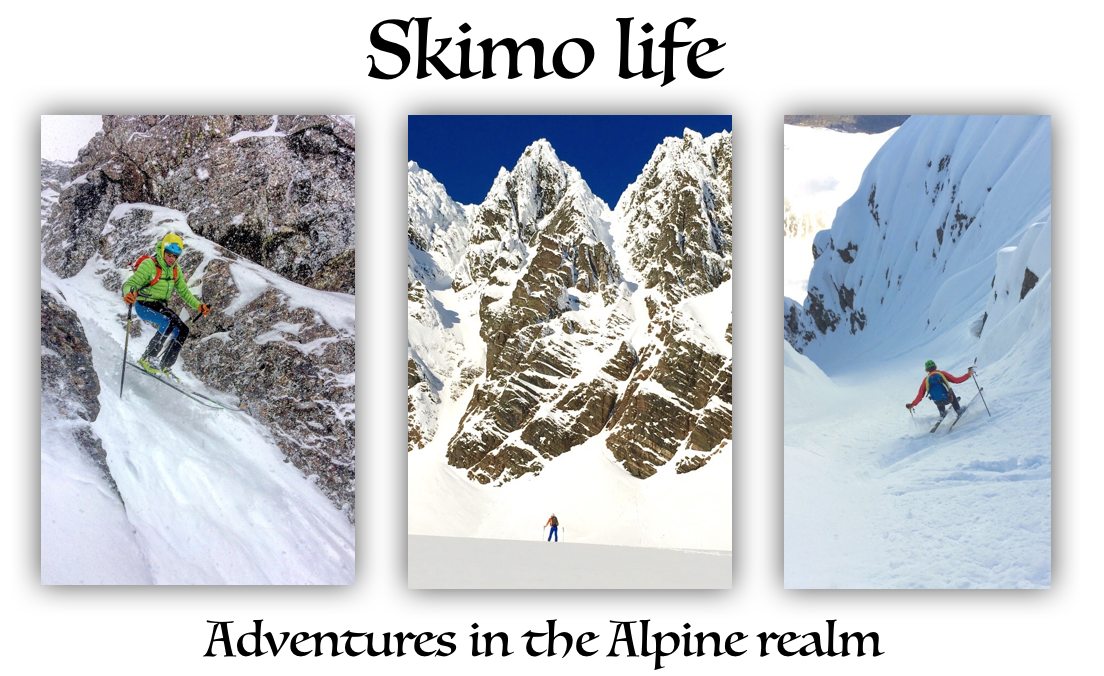Mount Moran Trip Report
 Tuesday, October 12, 2010 at 10:46PM
Tuesday, October 12, 2010 at 10:46PM Having abandoned the single-sport focus for the off-season, I've been bagging a few peaks in the last several weeks. Mostly this has been in the role of a guide, using old skills to get friends on top of objectives. Guiding for free is hard work but the reward of facilitating friends' goals makes it worthwhile. I started out getting three friends up Teewinot. Basically, 5,500 vertical feet straight up out of the parking lot. Good thing they were not paying me for my services as I made the all-too-common route finding error near the top, taking us 30 minutes out of the way. In spite of having been to the summit five or six times, I've nailed the route only half the time. It's always a relief to hear similar tales of misdirection from equally-experienced friends. Still frustrating.
Next up was a one-day ascent of the Grand Teton. Thankfully, this went much more smoothly. And smooth it should be after climbing the peak over 100 times now. As an Exum Guide I averaged 15 ascents each season. On this go, I had two very capable friends from Flagstaff, one of whom hails from Idaho Falls originally and had spied the peak for as long as he could remember. Finally helping him attain its summit was pretty cool.
Steve and Christy near the summit of the Grand Teton
A few laps on Snow King and my first-ever summit of Sleeping Indian followed, setting me up for a go on Mt. Moran's CMC route. Although having lived here for well over a decade my wife, Dina, had never climbed this trade route, a tick on every Teton climber's list. Her 35th birthday was lurking so, with a spell of perfect weather upon us, we decided to celebrate with a two-day ascent of this Teton classic. I have guided clients to it's top three times previously but it had been at least six years since my last go.
The thing that makes Moran unique is the approach. Although it is possible to get to the base of the mountain by foot, this involves an unsavory, trail-less bushwhack around the perimeter of Leigh Lake. The preferred mode of travel to the start of the climb is by boat via String Lake, a 300 meter portage followed by a crossing of Leigh Lake to the base of the route. Traditionally, this crossing is done in a canoe. Yuck! I am not an outdoorsman and do not fancy these tippy vessels. There is also a bit of skill needed to paddle one efficiently, something known as the "J" stroke, and the particulars have eluded me thus far. To persist in my avoidance of this skill, we opted for individual ocean kayaks, something with which I have more familiarity. Bringing two boats, of course, made the portage a little tedious but the tradeoff in the water was well worth it.
Most of the time, crossing Leigh Lake involves some wind and waves. Gales often roar out of Leigh Canyon like freight trains, whipping the water into a roiling nightmare in a canoe. I once had to delay a crossing with a client because the waves were breaking over the bow. We spent several hours ashore half way through the crossing, eating huckleberries while keeping one eye peeled for grizzly bears that frequent the woods in the area. I figured we could avoid a similar fate with vessels more suitable for such conditions. Fortunately, there was no wind. Actually, I have never seen this body of water so tranquil. It was literally like glass throughout the two days. What a pleasure to paddle!What's to say? Sun and perfect glass!
The approach was generally uneventful, although Dina cursed the weight of our boats during the awkward portage. My eight weeks of weight lifting helped me weather the effort somewhat better but I was still pumped lugging the 100 pounds of plastic and other gear some 300 meters overland…twice!
Smile! This thing is freakin' HEAVY!
 The "fun" looms ashore.
The "fun" looms ashore.
Once ashore at the base of the Falling Ice Glacier drainage, the mandatory swim took place before we organized and repacked our rucksacks for the 3,000 foot trudge to camp. We took turns swimming as I spied a black bear cruising the shoreline a few hundred meters away.  Bottom's up!He stayed away and we were soon climbing steadily toward the day's objective, the fabled CMC Camp. This is known in most guide books as the most beautiful camp in the range. With heavy-ish packs and some loose footing the walk is strenuous. The lack of wind and the trail's placement in the drainage made for a sweaty undertaking. The last thousand feet of the ascent are out on the ridge below camp and the going was cooler there. We were relieved to find no one else present at camp and it seemed we would have the mountain to ourselves.
Bottom's up!He stayed away and we were soon climbing steadily toward the day's objective, the fabled CMC Camp. This is known in most guide books as the most beautiful camp in the range. With heavy-ish packs and some loose footing the walk is strenuous. The lack of wind and the trail's placement in the drainage made for a sweaty undertaking. The last thousand feet of the ascent are out on the ridge below camp and the going was cooler there. We were relieved to find no one else present at camp and it seemed we would have the mountain to ourselves.
During most of the season, drinking water is found within a couple of hundred feet of camp. Late in the season, however, one has to traverse over to the main drainage across a tedious side hill. It's kind of creepy filling bottles with the Falling Ice Glacier icefall looming several hundred feet above. With the warm temperatures, there was lots of random rockfall up in the gut of the steep-sided gorge carved out by the glacier. Needless to say, I did not loiter any longer than I had to.
It was a still, windless night, uncomfortably warm, really. I had made a tasty, vegetable/chicken curry the night before and froze it in bags. They were still cold when we pulled them out for dinner. A few minutes in the Jet Boil along with some rice noodles and dinner was ready.  The evening's offering - chicken veggie curry - Yum!I followed that with a restless night of tossing and turning, unable to get comfortable for long. I practically had to sleep on top of my down bag, a strange experience at nearly 10,000 feet in October. Shitty sleep or not, I felt rested at 4:30 a.m. when the alarm rang. We brewed up and ate and were on our way in t-shirts. The approach is tedious in the dark with a couple of key diversions through steep rock bands. They're easy to miss if you don't keep your eyes peeled for the cairns marking the way.
The evening's offering - chicken veggie curry - Yum!I followed that with a restless night of tossing and turning, unable to get comfortable for long. I practically had to sleep on top of my down bag, a strange experience at nearly 10,000 feet in October. Shitty sleep or not, I felt rested at 4:30 a.m. when the alarm rang. We brewed up and ate and were on our way in t-shirts. The approach is tedious in the dark with a couple of key diversions through steep rock bands. They're easy to miss if you don't keep your eyes peeled for the cairns marking the way.
Once we were through the third class sections there was still another 30-40 minutes of slogging up a steep, loose trail to the top of Drizzlepuss, the rock tower/notch the marks the beginning of the difficulties. Sunrise over the West Horn from DrizzlepussWith a single rope it's two rappels down to the notch at the bottom of the 200 foot drop. There is no fixed anchor at the top so I down-climbed the steep but easy terrain to the anchor where Dina was waiting after rapping down. We each rapped the final pitch to the notch. From there it's roughly a thousand feet of easy fifth class slab, angling up and right toward the huge black dacite dike that prominently marks the center of Moran's huge east face. We simul-climbed the whole route and I stopped to belay after running out of gear three times. As I climbed, I could not help but think of Hans Johnstone, Mark Newcomb, Bill Dyer and Kent McBride skiing this line several winters ago. The whole face ripped a couple of days later in warming temps. Awesome!
The climb seemed to go on forever but, in fact, only took us about an hour and forty minutes to ascend.
 Spicy action butt shot!
Spicy action butt shot!Dina doing the Slabbadabbada-do-ya!The summit of Moran is a large, expansive plateau with unique views of of the rest of the range to the south.
The last few steps - GT down range
Chillin' on the summit
People often ask me how the "easy" route on Moran compares to the two classic lines on the Grand Teton. What separates the experiences of each is the greater sense of exposure on Moran in the middle of the broad east face and the heads-up nature of the decent. Much of getting off the Grand involves walking and scrambling down easy ledges before reaching the single 120' rappel to the Upper Saddle. On Moran, the scrambling is never relaxing and the route often unclear. Dina, having not climbed in over three years preferred the more relaxing and straight-forward nature of rappelling rather than down-climbing the route. We ended up stringing four rappels together before the base of Drizzlepuss. Just to remind me how much I hate rappelling, the final pull on the last one saw the rope get stuck behind a flake. Luckily I was able to solo up and free it but once again was reminded how quickly things can go south in what feels like a simple process.
By only placing a couple of directional anchors on the way up I was able to ascend the 200 feet of Drizzlepuss in one shot and belayed Dina up what I consider the best climbing on the route. Once at the top, it's over 4,000 feet down to the lake. Again, some of the third class terrain above camp keeps you from relaxing completely. I ran ahead and started breaking camp with Dina pulling in a few minutes later. We ate the rest of our real food leaving some Clif Blocks for the paddle out.
With only a few hikes a climbs in my legs this fall the punishment of the descent with a pack took its toll. I knew I would be sore. The sun went behind the mountains and the temperatures cooled nicely. I was still warm enough at the bottom to shed my clothes and dive straight into the lake. Although I have spent my adult life living and playing in the mountains, I grew up in and around the water and still find swimming in natural settings deeply pleasurable and cathartic, especially after a long day in the hills.
With mostly only cycling in her legs this summer, Dina was finding the descent to be more than a handful. The tricky boulders at the bottom did not disappoint, either. Shadows were long and the air was cooling rapidly. As she approached the bottom the words to my inquiry about whether she planned to swim before we paddled formed in my brain. Dina washing away memories of a long way down!But before I could utter a syllable she dropped her pack and, without slowing her trajectory toward the water, went straight in, shoes, clothes and all. I guess I had my answer. Definitely funny watching that unfold.
Once dry, we packed the boats and set off. For me, it was almost the best part of the day. It reminded me of the joy I feel when I ski into an alpine or ice climb and then get to ski powder on the way back to the car. Yes, the evening's paddle was kayaking powder. Nothing but glass and strange pockets of warm air to move effortlessly through to the far shore. If the paddle was blower pow' then the portage was breakable crust. We were tired and the boats heavy. We finished the last section of the paddle in fading light. We made short work of loading the gear and boats back on the van B-lined it straight for the Snake River Brew Pub and a welcomed feast of tasty fried goodness and burgers. - Brian
 Brian |
Brian |  5 Comments |
5 Comments | 





Reader Comments (5)
Very cool! You are lucky to live in such a great place. I skied the Skillet on Moran this last year and it was very cool. Other than the ski across the lake, I would do it every year! I am plotting on coming back this next year to attempt Buck and a few more. It's only 6 hours from Boise! Ha!
Hey, you can't move yet. I need a guided tour!
Shouldn't your weight training have helped keep your legs from getting sore on the descent? It seems like downhill hiking and downhill skiing use similar muscles. What exercises would be useful to keep the legs strong for downhills? Why didn't squats and lunges work for you? Thanks for any advice, there is a lot of great reading here!
Ahhh, now that is a great question, Scree. It's certainly no stretch to think that those weight training movements should have been "protective" to my shattered quads after that outing.
First of all, what's doing the "damage" here? Negative or eccentric movements and I do none of that all season on the bike. Cycling is pure concentric contraction. It's a shitty preparation for hiking downhill....not bad for the up but worthless for the down.
Weight training certainly has a eccentric component unless you are pushing/pulling a sled or car down the road. Otherwise, you have to slow down (eccentric) before going back up, as in the squat, for instance. Walking downhill involves thousands of single-leg decelerations.
I think what crushed me on Moran and any other early-season hike is the sheer volume of work done to get down from the summit and the frequent ballistic movements involved in moving downward through boulders. It's just now as controlled as a weight workout and there are thousands more repetitions than a weight training session.
That's my guess. Another perfect example of training specificity.
Excellent trip report. I too experienced a stuck rope on descent. But unlike you, I walked back instead of paddling. I don't recommend it.